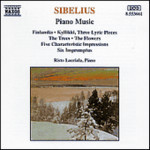
Sibelius: Piano Music (Incls 'Finlandia', 'three Lyric Pieces' & 'six Impromptus'
 $25.00
Out of Stock
$25.00
Out of Stock6+ weeks add to cart
JEAN SIBELIUS
Sibelius: Piano Music (Incls 'Finlandia', 'three Lyric Pieces' & 'six Impromptus'
Risto Lauriala (piano)
[ Naxos / CD ]
Release Date: Saturday 22 September 2007
This item is currently out of stock. It may take 6 or more weeks to obtain from when you place your order as this is a specialist product.
"Perfectly good playing and decent recording make this a useful alternative to the complete survey by Gimse, and it also enjoys the benefit of decent recorded sound." Penguin Guide
"Risto Lauriala is the pianist entrusted with the job and he is excellent. Overall, an interesting by-way, worth exploring."
- Classic CD - September 1996
When discussing the music of Jean Sibelius, it is not his piano pieces that come first to mind, after all, his reputation rests on his masterful writing for the orchestra. Sibelius, however did write piano music throughout his career, even though his own instrument was the violin. He was not a great piano composer, or, to be more exact, he never attained the grand keyboard style that he aspired to, despite attempts in that direction. All this notwithstanding, Sibelius's piano pieces do reflect his inner self and his own personal world in their own, sometimes quite modest, way.
Sibelius's piano music won scarcely any recognition in his lifetime. Erik Tawaststjerna expressed this quite neatly: "In the few cases where music writers and interpreters have considered them even worth the effort to discuss, they have magnanimously consigned them to the oubliette reserved for the minor solo instrument transgressions of great orchestral composers, such as the piano works of Berlioz, Wagner and Strauss." The composer himself, however, had faith in the future and popularity of his piano pieces.
One reason why Sibelius wrote such a great deal of piano music, over a hundred, was his chronic shortage of money. He once said to his daughter that he wrote small piano pieces instead of large orchestral poems so that she might have "butter on her bread, too". Since home music-making was quite popular at the turn of the century, there was a great demand for minor, fairly simple piano pieces. Sibelius, needing the cash, provided such pieces. He often sold them to Finnish publishers, hoping that these artistically insignificant bagatelles would not be distributed abroad and thus tarnish the reputation built by his orchestral output. He was disappointed in this, for his publishers in fact did quite well by reselling these works abroad.
In 1893, Sibelius put together the Six Impromptus, forming the first numbered piano work in his catalogue, Op. 5. Some he had written earlier, some just before publication. Sibelius had just completed his first extensive work, Kullervo, and the tone poem En Saga was in the process of gestation. The impromptus have a distinct air of expectation, and they do not have the same Sibelius spirit as the major works of that period. They are pale reflections of his other works: the first impromptu is based on the Quintet in G minor written in 1889, and the fifth and sixth are based on the melodrama Svartsjukans nätter (Nights of Jealousy). The second and fourth impromptus contain allusions to folk-tunes. This suite of impromptus is a clear indication that Sibelius was at that time only just maturing as a composer.
One of Sibelius's best-known works is no doubt Finlandia, originally written as one movement of incidental music to an anti-Russian entertainment in 1899. It became an independent work in the following year and attracted much attention from the very first with its patriotic nationalism. Sibelius wrote a piano arrangement of Finlandia himself, marvellously capturing the sturdiness and pomposity of the orchestral version, to which a choir was later added.
Tracks:
Kyllikki, Op. 41
5 Pieces for Piano, Op. 75, "Trees"
5 Pieces for Piano, Op. 85, "Flowers"
5 Characteristic Impressions, Op. 103
6 Impromptus, Op. 5
Finlandia, Op. 26 (arr. for piano)



